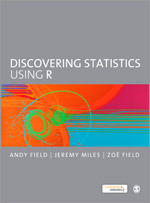Discovering Statistics Using R
- Andy Field - University of Sussex, UK
- Jeremy Miles - RAND Corporation, USA
- Zoë Field - University of Sussex, UK
Keeping the uniquely humorous and self-deprecating style that has made students across the world fall in love with Andy Field's books, Discovering Statistics Using R takes students on a journey of statistical discovery using R, a free, flexible and dynamically changing software tool for data analysis that is becoming increasingly popular across the social and behavioural sciences throughout the world.
The journey begins by explaining basic statistical and research concepts before a guided tour of the R software environment. Next you discover the importance of exploring and graphing data, before moving onto statistical tests that are the foundations of the rest of the book (for example correlation and regression). You will then stride confidently into intermediate level analyses such as ANOVA, before ending your journey with advanced techniques such as MANOVA and multilevel models. Although there is enough theory to help you gain the necessary conceptual understanding of what you're doing, the emphasis is on applying what you learn to playful and real-world examples that should make the experience more fun than you might expect.
Like its sister textbooks, Discovering Statistics Using R is written in an irreverent style and follows the same ground-breaking structure and pedagogical approach. The core material is augmented by a cast of characters to help the reader on their way, together with hundreds of examples, self-assessment tests to consolidate knowledge, and additional website material for those wanting to learn more.
Given this book's accessibility, fun spirit, and use of bizarre real-world research it should be essential for anyone wanting to learn about statistics using the freely-available R software.
Supplements
It would not serve my course needs/purposes as well as Field's Discovering Statistics Using SPSS.
Actually, using for Stat/Design III as a capstone course... Students love it!
This is optional for students who want to go into quantitative research.
Reader friendly and pleasant to read, a customary trade of Fields. Definitely recommended for those who want to try and adopt R
Excellent and very clear! Will be recommending this text book to those studying the use of R in the social sciences.
This is a really well written and comprehensive text - for those interested in learning to use R then an invaluabel guide. Field's books are always high quality and engaging.
Discovering statistics using R is a fully comprehensive introduction to understanding how to set up experimental research using statistics and how to collect the data for analysis using the R-chitecture. The text contains 19 chapters which cover: what to measure when collecting data in relation to identifying what variables to measure when setting up experiments, and what to consider in terms of the validity and reliability of the experiments being designed in relation to the credibility and dependability of the results. How to measure variables is explained in relation to: correlational research and experimental research methods with regards to making decisions about: populations, samples, randomisation and setting up experimental control groups. The book also discusses using statistical models to test research questions, and covers frequency distribution and its relation to the normal distribution of data in terms of positive or negative skew, as well as, the standard error and type I and type II errors, effect sizes and statistical power.
Other chapters of the book concentrate on what the reader needs to know about R in terms of the R-chitecture. How to download and install R are covered, as well as the benefits and limitations of R.
The layout of the R interface is explained to the reader in terms of the menus that are available to the user and their functions, as well as, how to create variables and run tests within R. The book also contains a useful glossary of terms and appendix of useful charts of information about the standard normal distribution and the critical values of the t-distribution, F-distribution, and the chi-square distribution.
This book is suitable to anyone undertaking statistical research within the social sciences using the R chitecture. The text is accessible to undergraduate and postgraduate students undertaking research projects and is also useful for professionals seeking to implement R-chitecture as part of the analysis phase of research.
1. Andy Field authorship
2. Use of R software
We have no required textbook for this course, but I will definitely recommend it as a good basic statistics book and a good beginner's resource for R.
We teach several basic (bio)statistics courses for MS and PhD students for which no text is required. Since these students could use both a basic statistics textbook and a basic R resource, I will definitely recommend this book.









